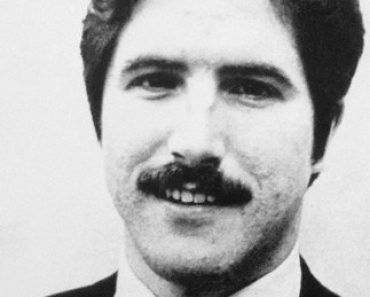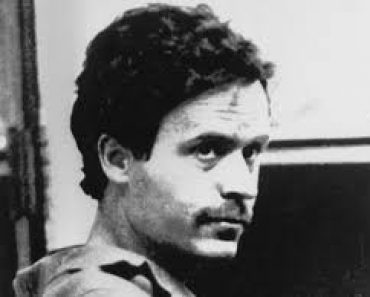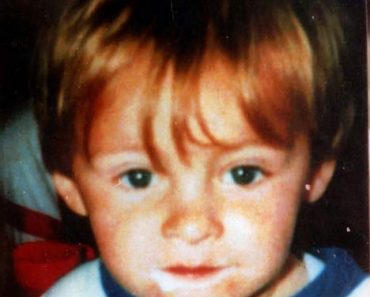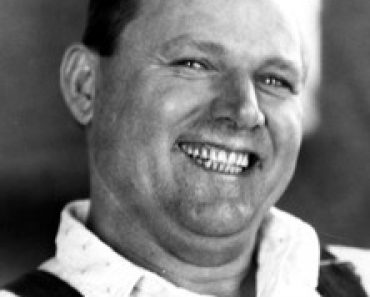Jared Loughner is an American who pled guilty to 19 charges of murder and attempted murder, in connection with the shooting in Tucson, Arizona, on January 8, 2011, that killed six people, including Chief U.S. District Court Judge John Roll, as well as a 9-year-old girl, Christina-Taylor Green. The shooting also left 14 others injured, including U.S. Representative Gabrielle Giffords.
 Personal Background
Personal Background
Jared Loughner is the only child of Randy and Amy Loughner. They were described by a neighbor as a very private family. While Jared had friends in high school, neighbors noted that in the years following he would keep to himself and not respond to others.
Behavior Change
Loughner attended Mountain View High School, and dropped out in 2006. Around this time, those who knew him noted a change in his personality. Kelsey Hawkes, who dated Jared Loughner for several months in high school, later said she could not believe it was him after hearing of his arrest. “I’ve always known him as the sweet, caring Jared”, said Hawkes, 21, then a student at the University of Arizona.
At some point, Jared Loughner was fired from his job at a Quiznos restaurant, with his manager saying he had undergone a personality transformation. After this, Loughner briefly volunteered at a local animal shelter, walking dogs, but he was asked not to return. The shelter manager later said, “He was walking dogs in an area we didn’t want dogs walked…he didn’t understand or comprehend what the supervisor was trying to tell him. He was just resistant to that information.”
According to court records, Jared Loughner had had two previous offenses: in October 2007, he was cited in Pima County for possession of drug paraphernalia and on October 13, 2008, he was charged after defacing a street sign in Marana, near Tucson (which was dismissed following the completion of a diversion program in March 2009).
 Drug and Alcohol Use
Drug and Alcohol Use
Zach Osler, a high school classmate of Loughner’s, and his closest friend, indicated that Loughner’s life began to unravel after his high school girlfriend broke up with him, and he then began to abuse alcohol and other drugs, specifically Salvia divinorum (a natural hallucinogen illegal in some states). Another longtime friend, Kylie Smith, added that he had used cannabis (marijuana), psychedelic mushrooms, and LSD around that same time. Jared Loughner quit using marijuana (as well as alcohol and tobacco) in late 2008 and has not used it since, according to one of his longtime friends. The U.S. Army confirmed that Loughner had been rejected as “unqualified” for service in 2008. According to military sources, Jared Loughner admitted to marijuana use on numerous occasions during the application process.
Suspension From School
From February to September 2010, while a student at Pima Community College, Jared Loughner had five contacts with college police for classroom and library disruptions. On September 29, 2010, college police also discovered a YouTube video shot by Loughner, in which his spoken commentary stated that the college was illegal according to the United States Constitution. He described his school as “one of the biggest scams in America”. The video led to Loughner being suspended from the school.
The college told Loughner that if he wanted to come back to school, he needed to resolve his code of conduct violations and obtain a mental health clearance (indicating, in the opinion of a mental health professional, that his presence did not constitute a danger to himself or others). On October 4, Jared Loughner and his parents met with campus administrators and Loughner indicated he would withdraw from the college. During Loughner’s time at Pima, a classmate said she thought he might commit a school shooting. One of his teachers has claimed a similar suspicion after the Tucson shooting.
Views On Politics
Records show that Jared Loughner was registered as a Republican and voted in 2006 and 2008, but not in 2010. A YouTube channel under an account called “Classitup10” was linked to Loughner. (There have been numerous copies of ‘impostor accounts’ such as ‘JaredLoughner and Classitup1O.)
Loughner’s high school friend Zach Osler said, “He did not watch TV; he disliked the news; he didn’t listen to political radio; he didn’t take sides; he wasn’t on the Left; he wasn’t on the Right.” But a former classmate, Caitie Parker, who attended high school and college with Loughner, described his political views as “left wing, quite liberal,” “radical.”
In the aftermath of the shooting, the Anti-Defamation League reviewed messages by Jared Loughner, and concluded that there was a “disjointed theme that runs through Loughner’s writings”, which was a “distrust for and dislike of the government”, which “manifested itself in various ways”–for instance, the belief that the government used the control of language to brainwash people, the notion that the government was creating “infinite currency” without the backing of gold and silver, or the assertion that NASA was faking spaceflights.
Dislike for Gabrielle Giffords
According to a former friend, Bryce Tierney, Jared Loughner had exhibited a longstanding dislike for Gabrielle Giffords. Tierney recalled that Loughner had often expressed a view that women should not hold positions of power. He repeatedly derided Giffords as a “fake”. This belief intensified after he attended her August 25, 2007 event when she did not, in his view, sufficiently answer his question: “What is government if words have no meaning?” (Loughner kept Giffords’ form letter, which thanked him for attending the 2007 event, in the same box as an envelope which was scrawled with phrases like “die @#!*%” and “assassination plans have been made”.) Zane Gutierrez, a friend, later told the New York Times that Loughner’s anger would also “well up at the sight of President George W. Bush, or in discussing what he considered to be the nefarious designs of government.”
Conspiracy Theories
His friend Zach Osler noted that conspiracy theories had a profound effect on Loughner, particularly the online conspiracy theory film Zeitgeist: The Movie, with which friends claimed Jared Loughner held an obsession. He was a member of the conspiracy theory message board Above Top Secret, although members of the site did not respond warmly to his posts. Loughner espoused 9/11 conspiracy theories, New World Order conspiracy theories, and beliefs in a 2012 apocalypse, among other controversial viewpoints. Reports appearing after the shooting noted similarities between the statements made by Loughner and the views of conspiracy theorist David Wynn Miller. The Anti-Defamation League’s report also confirmed Loughner’s longstanding interest in conspiracy theories.
Views on Religion
While there was a great deal of speculation about Jared Loughner being anti-Semitic due to his hatred of and attempted murder of Rep. Giffords, who is Jewish, the Anti-Defamation League’s analysis of the messages by Loughner found that he had a more generalized dislike of religion. Loughner declined to state his religion in his Army application, and has stated that “God couldn’t be a possible” and “I won’t trust in God!” on YouTube and Internet forums.
Changes in Attitude and Demeanor
Tong Shan, a former friend and classmate of Loughner’s, recalled observing significant changes in his attitude and demeanor a year prior to the shooting. Shan, who became friends with Jared Loughner on the day of their high school graduation, said that they would often spend time together after class but lost touch after the semester ended. When they met again in mid-2010, Shan recalled that Loughner appeared “radically different”. “From the way he was talking to me [online]…you can see. It was just questions and questions and random, weird questions that didn’t go together,” she said. “He wanted to know everything…he would just trip out.” Recounting her early experiences with Loughner in light of the shooting, Shan said Loughner was “a good person that just somehow changed so much. I don’t know what the hell happened to him.” Shan stated that her last encounter with Loughner was in October 2010, after he was suspended and dropped out of school and just before he purchased the semi-automatic handgun used in the massacre. She said that while Jared Loughner was “anti-government,” he never appeared violent, nor did he ever mention his plans to buy a gun.
Several classmates recalled an incident in which Loughner, during a class discussion, had mocked and laughed at a young woman who was describing her abortion. One classmate described Loughner’s reaction as “wildly inappropriate”. “(Jared Loughner ) started making comments about terrorism and laughing about killing the baby,” former classmate Don Coorough recalled to ABC News. Yet another classmate, Lydian Ali, recalled that “a girl had written a poem about an abortion. It was very emotional and she was teary eyed and he said something about strapping a bomb to the fetus and making a baby bomb out of it.”
Jared Loughner
Former classmate Caitie Parker remembered Loughner as a “pot head”. Loughner has a history of drug use, having been arrested in September 2007 for possession of marijuana and drug paraphernalia. “I haven’t seen him in person since ’07,” Parker recalled in early 2011. “I’m looking back at this [as] a 14–19 year old…who knows if any of us knew what for sure we were yet.”
Jared Loughner also became obsessed with controlling what he perceived to be lucid dreams.
The Tucson Shooting
Jared Loughner allegedly purchased a 9mm Glock pistol used in the shooting from a Sportsman’s Warehouse in Tucson on November 30, 2010. The night before the shooting, he left a message on a friend’s voicemail saying, “Hey man, it’s Jared. Me and you had good times. Peace out. Later.” In a Myspace post the morning of the shooting at 4:12 am, he wrote “Goodbye friends. Please don’t be mad at me. The literacy rate is below 5%. I haven’t talked to one person who is literate. I want to make it out alive. The longest war in the history of the United States. Goodbye. I’m saddened with the current currency and job employment. I had a bully at school. Thank you. P.S. –plead the fifth!” Photos on the Myspace page showed a close-up picture of a handgun sitting atop a document titled “United States History.”
 At 7:04 am MST (UTC-7), Jared Loughner went to a Wal-Mart store in the Foothills Mall to purchase ammunition but left the store and completed his purchase at a Super Wal-Mart on North Cortaro Road at 7:28 am. He was stopped by an Arizona Game and Fish Department officer at 7:34 am MST (UTC-7) for running a red light but once the officer determined there were no outstanding warrants for Loughner, he was allowed to proceed to his destination with a warning to drive carefully. He then took a taxi to a Safeway supermarket location in Casas Adobes, where Giffords was holding a constituents meeting. The shooting occurred on January 8, 2011 at 10:10 am MST (UTC-7). Loughner allegedly opened fire on Giffords, as well as numerous bystanders, killing six people. Thirteen other people were injured by gunfire, and one person was injured while fleeing the scene of the shooting. Giffords, the apparent target of the attack, was shot in the head and left in critical condition.
At 7:04 am MST (UTC-7), Jared Loughner went to a Wal-Mart store in the Foothills Mall to purchase ammunition but left the store and completed his purchase at a Super Wal-Mart on North Cortaro Road at 7:28 am. He was stopped by an Arizona Game and Fish Department officer at 7:34 am MST (UTC-7) for running a red light but once the officer determined there were no outstanding warrants for Loughner, he was allowed to proceed to his destination with a warning to drive carefully. He then took a taxi to a Safeway supermarket location in Casas Adobes, where Giffords was holding a constituents meeting. The shooting occurred on January 8, 2011 at 10:10 am MST (UTC-7). Loughner allegedly opened fire on Giffords, as well as numerous bystanders, killing six people. Thirteen other people were injured by gunfire, and one person was injured while fleeing the scene of the shooting. Giffords, the apparent target of the attack, was shot in the head and left in critical condition.
The Arrest of Jared Loughner
Jared Loughner was subdued by bystanders and was arrested by police, saying, “I plead the Fifth,” as he was taken into custody. A photograph taken by the Pima County Sheriff’s Office’s forensic unit was released to the media on January 10, 2011 and published on front pages nationwide. The Washington Post described the picture as “smirking and creepy, with hollow eyes ablaze,” while the art director for the New York Times stated it was placed on the front page because it “was the picture of the day […] it was intense and arresting. It invited you to look and study, and wonder.”
Charges and Imprisonment
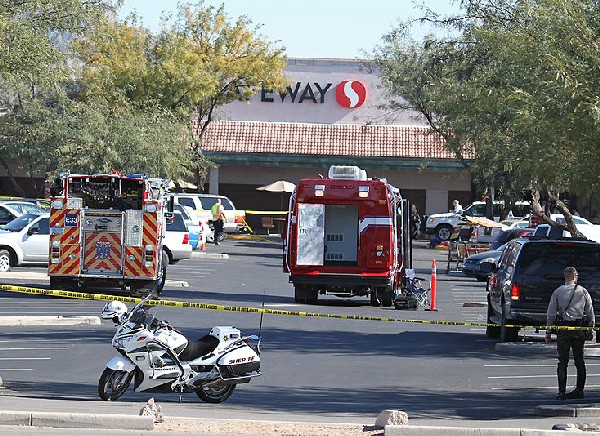 Loughner was charged in federal court with one count of attempted assassination of a member of Congress, two counts of murder of a federal employee (including Judge Roll), and two counts of attempting to murder a federal employee. He was indicted on three of the charges on January 19, 2011. Loughner was held without bail in the Federal Correctional Institution at Phoenix, kept isolated from other inmates 23 hours a day and allowed out of his cell for just one hour a day to shower and exercise. On February 24, 2011, he was transferred to the United States Penitentiary in Tucson.
Loughner was charged in federal court with one count of attempted assassination of a member of Congress, two counts of murder of a federal employee (including Judge Roll), and two counts of attempting to murder a federal employee. He was indicted on three of the charges on January 19, 2011. Loughner was held without bail in the Federal Correctional Institution at Phoenix, kept isolated from other inmates 23 hours a day and allowed out of his cell for just one hour a day to shower and exercise. On February 24, 2011, he was transferred to the United States Penitentiary in Tucson.
Attorney Judy Clarke, a former federal public defender who in the past had represented suspects in several high profile murder and terrorism cases, was appointed to represent Loughner in federal court. The entire federal judiciary of the state of Arizona recused themselves from hearing the case because of their ties to victim and fellow judge, John Roll. Federal prosecutors opposed motions to move the case outside of Arizona because of pre-trial publicity. At the direction of Ninth Circuit Appeals court Chief Judge Kozinski, the federal case was assigned to San Diego-based Judge Larry Alan Burns (from the Southern District of California).
Prosecutors representing Arizona, which has concurrent jurisdiction in the matter, announced they intended to file murder and attempted murder charges on behalf of the other victims, those who were not members of Congress or federal employees (although they could legally file charges on behalf of all the victims). Arizona law does not permit a verdict of “not guilty by reason of insanity”, but does allow for a verdict of “guilty but insane.”
Initial Pleading and Additional Charges
On January 24, 2011, Jared Loughner appeared at the Sandra Day O’Connor U.S. Courthouse in Phoenix, before Judge Larry Alan Burns from San Diego. Loughner, whose hair had partially regrown since his arrest, smiled while presented with the charges related to the shooting, including the attempted killing of Giffords and two of her aides. Loughner’s attorney, Judy Clarke, requested that Judge Burns select a plea on her client’s behalf, to which a plea of not guilty was recorded. When Burns asked Clarke if Loughner understood the charges against him, she replied that they were “not raising that issue” at the time. She also did not object to a request by prosecutors to have future hearings moved back to Tucson.
On March 3, 2011, a federal grand jury indicted Jared Loughner on additional charges of murder and attempted murder for a total of 49 counts. On March 9, 2011, Loughner pleaded not guilty to all 49 charges.
Relationship with Lawyers
On May 25, 2011, Judge Burns stated, “I got some letters declaring some conflict with his counsel…I intend to table them at this time. At such a point that his competency is restored, if he wants to bring up the matter of counsel, he can renew it then.” The judge suppressed the letters from the court record.
Medico-Legal Proceedings
On May 25, 2011, Judge Burns ruled Jared Loughner was then incompetent to stand trial. Court proceedings were suspended while Loughner, who has been diagnosed with schizophrenia, undergoes psychiatric treatment at the psychiatric wing of the U.S. Medical Center for Federal Prisoners in Springfield, Missouri. He was scheduled to appear in court on September 21, 2011, but that hearing was delayed until September 28, 2011, when the judge reviewed whether he could understand the charges against him and could assist in his own defense. (Loughner’s lawyers unsuccessfully objected to him appearing at the hearing.) Loughner disrupted the court hearing with an outburst, and was carried from the court room. According to the New York Times, Jared Loughner believes he succeeded in killing Giffords, and clashed with his lawyer when she informed him that the congresswoman had survived.
Forced Medication Rules
On June 26, 2011, Judge Burns ruled that prison doctors could forcibly medicate Loughner with antipsychotic drugs in order to make him fit to stand trial. However, on July 12, 2011, a three-judge federal appeals panel from the Ninth Circuit ruled that Loughner could refuse anti-psychotic medication, since he “has not been convicted of a crime, is presumptively innocent and is therefore entitled to greater constitutional protections than a convicted inmate.” However, the ruling stated that it “does not preclude prison authorities from taking other measures to maintain the safety of prison personnel, other inmates and Jared Loughner himself, including forced administration of tranquilizers”.
A week after the ruling, prison medical authorities resumed forcible treatment of Loughner with the antipsychotic risperidone, this time citing Washington v. Harper and stating the purpose of treatment was the need to control the danger he posed to himself and others in prison, rather than rendering him fit for trial. Loughner’s defense team submitted an emergency motion to the United States Court of Appeals for the Ninth Circuit claiming that this treatment was in violation of their ruling and seeking an immediate injunction to halt treatment. The request for an injunction was denied by the court, allowing treatment to continue pending a full hearing into the matter. Arguments began on August 30 as to the lawfulness of this treatment, and in March 2012 a federal appeals court denied a request by Loughner’s lawyers to halt his forced medication.
On May 24, 2012 a federal judge ordered a competency hearing for June 27 (later postponed until August 7) to determine Loughner’s mental fitness to stand trial . He remained at a federal prison hospital in Missouri pending the entry of his plea. A request by Loughner’s lawyers to rehear arguments on forced medication was denied on June 5, 2012.
 Guilty Plea and Sentencing
Guilty Plea and Sentencing
On Tuesday, August 7, 2012, Judge Burns found Jared Loughner competent to stand trial. Loughner pleaded guilty to 19 counts at the hearing, which spared him the death penalty. The hearing began with Loughner listening calmly to testimony from Dr. Christina Pietz, Loughner’s forensic psychologist, who testified that he had displayed depressive symptoms in 2006 and was formally diagnosed with schizophrenia in 2011. Dr. Pietz then stated that she believed that, after having been forcibly medicated for more than a year, Loughner had expressed remorse and was a changed individual, and that he was competent to stand trial and agree to a plea. Sentencing was set for November 15, 2012 at 10 a.m. local time. The sentence could not include the death penalty, because the guilty plea bargain was made with an assurance that it would not be sought; Loughner therefore under the law faced a mandatory sentence of life imprisonment without the possibility of parole. Former U.S. Representative Gabrielle Giffords and her husband, retired NASA astronaut Mark Kelly, U.S. Representative Ron Barber, a former aide to Mrs. Giffords, U.S. Attorney General Eric Holder, and the U.S. Attorney for Arizona, John S. Leonardo, had all approved the plea, which was offered and accepted after consultation with them and with the loved ones of the other victims.
Jared Loughner, by pleading guilty in the deal, automatically then waived his right to any further appeals and cannot later alter his plea to an insanity plea. Loughner must pay a restitution of $19 million, $1 million for each of the victims. He forfeited the weapons he used in the incident, and any money earned from efforts to sell his story. Loughner calmly answered that he understood each charge, and signed his initials after each page of the agreement and shakily signed his name to it, dated August 6.
On November 8, 2012, Jared Loughner appeared in front of U.S. District Court Judge Larry Alan Burns, some of the victims he shot and relatives of those killed in a Tucson court. He was sentenced to serve seven consecutive life terms plus 140 years in prison without parole.
credit murderpedia / wikipedia







